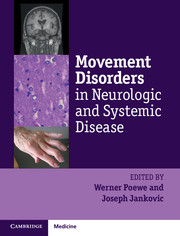Book contents
- Frontmatter
- Contents
- List of contributors
- List of videos
- List of abbreviations
- Preface
- Section I General principles
- Section II Movement disorders in systemic disease
- Section III Iatrogenic and toxic movement disorders
- Section IV Movement disorders in general neurology
- Section V Systemic complications of movement disorders
- Chapter 24 Dysautonomia in movement disorders
- Chapter 25 Gastrointestinal complications of movement disorders
- Chapter 26 Respiratory complications of movement disorders
- Chapter 27 Movement disorders emergencies
- Index
- Plate Section
- References
Chapter 25 - Gastrointestinal complications of movement disorders
from Section V - Systemic complications of movement disorders
Published online by Cambridge University Press: 05 April 2014
- Frontmatter
- Contents
- List of contributors
- List of videos
- List of abbreviations
- Preface
- Section I General principles
- Section II Movement disorders in systemic disease
- Section III Iatrogenic and toxic movement disorders
- Section IV Movement disorders in general neurology
- Section V Systemic complications of movement disorders
- Chapter 24 Dysautonomia in movement disorders
- Chapter 25 Gastrointestinal complications of movement disorders
- Chapter 26 Respiratory complications of movement disorders
- Chapter 27 Movement disorders emergencies
- Index
- Plate Section
- References
Summary
Introduction
Gastrointestinal (GI) symptoms often accompany movement disorders, either as a result of the primary disorder or as a side effect of pharmacotherapy. Recognition of GI symptoms requires vigilance on the part of clinicians, and differentiating GI symptoms caused by the underlying disease from those that are side effects of medications necessitates a thoughtful approach. Directed questions about GI symptoms should be asked routinely during clinic visits in order to identify and subsequently address these vexing and potentially dangerous problems. This chapter aims to assist clinicians in this important endeavor by providing a review of the available literature on GI complications of movement disorders, as well as concise information on the most common GI side effects of movement disorder medications. Information on the work-up and management of GI complications is also presented where appropriate. The movement disorders covered in this chapter are those for which there is a body of medical literature on associated GI complications. Readers should note that the available literature on this topic is exceedingly limited for all movement disorders except Parkinson’s disease, making the information presented herein far from complete.
Parkinson’s disease
GI symptoms, which reflect dysregulation of GI motility, are highly prevalent in PD. Aside from their negative impact on quality of life, GI symptoms in PD can be associated with life-threatening complications, including malnutrition, pulmonary aspiration, megacolon, and intestinal obstruction; furthermore, they frequently lead to emergency admissions in the PD population (Visser et al. 2008; Barone et al. 2009; Guneysel et al. 2008; Caplan et al. 1965). GI symptoms also have the potential to affect other PD symptoms. For example, gastroparesis and subsequent late arrival at intestinal absorption sites can lead to erratic absorption of levodopa with resultant motor fluctuations (Djaldetti et al. 1996; Kurlan et al. 1988). The pathophysiological underpinnings of the deranged gut motility in PD are not known. Alpha-synuclein pathology has been demonstrated in colonic submucosa from subjects with early, untreated PD and in a small number of subjects prior to PD diagnosis (Shannon et al. 2012a; Shannon et al. 2012b). While this finding has implicated colonic alpha-synuclein pathology as a potential biomarker for premotor PD, the pathology has yet to be correlated with objective motility data or subjective GI symptoms. The most commonly occurring GI symptoms in PD are weight loss, sialorrhea, dysphagia, nausea, constipation, and defecatory dysfunction, each of which is discussed separately.
- Type
- Chapter
- Information
- Movement Disorders in Neurologic and Systemic Disease , pp. 383 - 397Publisher: Cambridge University PressPrint publication year: 2014



